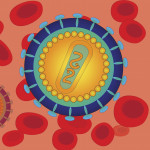Cocaine may raise the likelihood of acquiring HIV and also fuel the virus’ spread from cell to cell. After exposing what are known as quiescent, or inactive, CD4 cells to cocaine, researchers at the University of California, Los Angeles put them in contact with HIV. While these immune cells are typically resistant to HIV, the investigators found that just three days of drug exposure was enough to make them more susceptible to infection. The drug accomplished this by stimulating a pair of receptors on the cells’ surface, similar to the way cocaine latches onto brain cells and spurs its psychoactive effects. In turn, these once-dormant, newly infected CD4s could set to work churning out more virus to go infect a pool of infectible cells that had now swelled thanks to the drug.
The study’s senior author, Dimitrios Vatakis, PhD, an assistant professor of medicine at UCLA, cautioned that his team’s research is limited by the fact that it was conducted in a lab setting and that three days of cocaine exposure doesn’t necessarily reflect that of the typical user. But he says its findings raise important questions about the role cocaine may play in driving the epidemic.
“Drugs on their own,” Vatakis explains, “can create the conditions that will allow for an infection to be more productive.”
Cocaine Fuels HIV






Comments
Comments